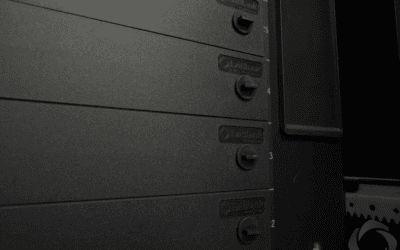Data centers stay cool using a combination of airflow optimization, free cooling strategies, and advanced liquid cooling systems. These methods reduce power consumption, improve PUE (Power Usage Effectiveness), and support energy-efficient operations without depending entirely on high-consumption HVAC systems or constant water usage. Efficient cooling is engineered into every part of the infrastructure.
How Data Centers Reduce Cooling Waste Through Design
Modern data centers are designed to minimize thermal inefficiencies while maximizing cooling performance. Most strategies begin with airflow engineering, segmenting hot and cold airflows, and managing them separately to avoid recirculation and unnecessary energy loss.
Many operators utilize cold aisle containment systems to separate intake air from heat exhaust. This includes using blanking panels to seal unused RU spaces and brush grommets to block open cable passages, ensuring airflow travels only where it’s needed. These passive tools eliminate bypass air and contribute to better rack-level cooling, especially when paired with sensor-based thermal tracking.
As discussed in our post on the top mistakes in airflow management, mismanaging air direction can drastically increase energy load. This is where the containment strategy becomes central, not optional.
What Is Free Cooling and When Does It Work Best?
Free cooling reduces reliance on mechanical systems by using the external environment to assist cooling efforts. It can be highly effective in regions with cooler climates, where ambient air or water can help lower the temperature of IT equipment.
Two types are widely used:
- Air-side economizers draw outside air into the facility and expel heat, often mixed with return air for balance.
- Water-side economizers use external bodies like rivers or aquifers to pre-chill the liquid coolant circulated internally.
Free cooling works well when external temperatures stay within operational thresholds. For warmer or humid environments, hybrid systems often combine free cooling with mechanical chillers for stability.
Why Liquid Cooling Is Becoming a Standard for High-Density Setups
As server densities rise, especially for AI, machine learning, and GPU workloads, liquid cooling has emerged as a more efficient method of heat extraction. Instead of cooling the entire room, liquid systems focus on component-level heat absorption, increasing efficiency, and reducing wasted airflow.
Two major configurations are common:
- Direct-to-chip cooling, where cold plates are mounted directly onto CPUs or GPUs.
- Immersion cooling which submerges full servers into non-conductive fluid for uniform heat dissipation.
Compared to traditional CRAC units, liquid systems often reduce both floor space and operational noise. Combined with our containment-supported rack designs, they offer an excellent solution for performance-focused environments.
What Role Does Airflow Containment Play in Energy Savings?
Airflow containment systems are essential for directing cooled air to the right places and stopping heat recirculation. Most modern designs separate “hot aisles” and “cold aisles,” guiding airflow using barriers, panels, and sealed tiles.
Key components include:
- Blanking panels to cover unused RU slots in racks.
- Brush grommets for sealing floor cable openings.
- Directional airflow tiles that distribute cooled air upward toward intake vents.
These tools prevent conditioned air from escaping into hot zones or mixing inefficiently. They are part of our modular ecosystem, working together to lower PUE without complex retrofits.
You can learn more about the value of these passive airflow tools in our post on the science behind blanking panels.
Do Data Centers Waste That Much Water?
Water use is a common concern, but not all cooling systems consume large volumes. Many facilities now use closed-loop systems, where water is recycled rather than discarded. Evaporative cooling systems, which use water to cool intake air, are typically more efficient than mechanical chillers and are favored in dry regions.
In high-demand scenarios, liquid cooling can also operate with minimal evaporation losses by using sealed heat exchangers. As we’ve explored in our article on low-cost cooling solutions, sustainable cooling doesn’t require endless water; it requires smarter engineering.
How Heat Reuse Can Support Energy Optimization
Instead of venting waste heat, some data centers are now capturing it for secondary use. This is especially effective in colder regions where low-grade heat can support:
- District heating networks that warm nearby offices or residential areas.
- On-site reuse, like powering water heaters or backup generator rooms.
Proper airflow separation and containment help collect this heat more efficiently, offering another layer of sustainability without new infrastructure.
Monitoring Tools That Optimize Cooling Efficiency
Real-time monitoring and smart controls play a major role in preventing overcooling and detecting inefficiencies. Most facilities now track:
- PUE (Power Usage Effectiveness)
- WUE (Water Usage Effectiveness)
- REF (Rack Energy Factor)
- COP (Coefficient of Performance)
When paired with airflow tools like blanking panels and grommets, these systems improve rack-level targeting. Our solutions are designed to complement these metrics by reducing the cooling volume needed per server.
If you’re curious how poor air control affects performance, see our guide on the hidden costs of poor airflow.
Our Role in Supporting Efficient Cooling Infrastructure
Cooling efficiently is not only a performance requirement, it’s a responsibility. That’s why our product line supports all major cooling strategies through passive, scalable airflow tools.
These include:
- Modular blanking panels that adapt to multiple RU heights
- Snap-fit brush grommets to seal underfloor cabling
- Directional airflow floor tiles for rack-by-rack cooling
- Panel mounting solutions for easy installation into any rack layout
Whether you’re aiming to lower PUE or simply reduce overcooling costs, our tools offer measurable value across diverse data center environments.
Need to reduce cooling load without changing core systems?
Explore our next-gen blanking panel innovations and see how airflow control can start right at the rack.




